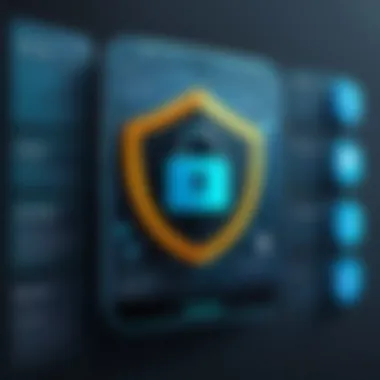Exploring Multi User Task Manager Applications


App Overview
Preface to Multi User Task Manager Apps
Multi user task manager applications are tools designed to enhance collaborative project management. These apps enable multiple users to work on tasks simultaneously, share updates, and track progress efficiently. In a world where remote work and team collaboration have become increasingly common, such tools are essential for ensuring productivity and organization.
Key Functionalities and Benefits
- Collaboration Tools: Users can share tasks, assign responsibilities, and communicate in real-time within the app. This feature fosters teamwork.
- Progress Tracking: The ability to monitor the status of tasks boosts accountability. Users can see what has been completed and what is still pending.
- Integration Capabilities: Many multi user task managers integrate with other software, such as calendars and file-sharing services. This enhances workflow efficiency.
- Accessibility: Being cloud-based allows these apps to be used from various devices. Users can update and check tasks on-the-go.
- Customization Options: Users can often tailor settings to fit specific team needs, including custom labels and categories.
These functionalities create a robust environment where teams operate cohesively, enhancing overall productivity.
Step-by-Step Walkthrough
To effectively utilize a multi user task manager app, follow these steps:
- Sign Up: Navigate to the app’s website or download it on your device. Fill in the required information to create an account.
- Create a New Project: Once logged in, click on the "New Project" button on the dashboard. Input the necessary project details.
- Add Users: Navigate to the project settings. Here, you can invite team members by entering their email addresses.
- Assign Tasks: After adding users, start creating task cards. Assign these tasks to team members, setting deadlines as needed.
- Monitor Progress: Use the dashboard to track the completion of tasks and provide feedback.
Tips and Tricks
- Use Notifications: Enable notifications to stay updated on changes to tasks and deadlines.
- Leverage Labels: Use color coding or labels for better task organization.
- Explore Shortcuts: Familiarize yourself with keyboard shortcuts for faster navigation in the app.
These practices can help maximize your efficiency within the app.
Common Issues and Troubleshooting
Users may encounter several typical issues:
- Synchronization Problems: Sometimes updates do not appear across all devices.
- Unauthorized Access: Concerns about security are valid.
- Overlapping Tasks: Sometimes tasks can get mixed up if two users edit simultaneously.
- Solution: Ensure you have a stable internet connection and refresh the app.
- Solution: Regularly update passwords and enable two-factor authentication.
- Solution: Encourage users to communicate before making changes.
Understanding these issues can save time and enhance user experience.
App Comparison
In comparing various multi user task manager apps, consider the following:
- Trello vs. Asana: Trello is renowned for its visual task boards while Asana offers a more structured project management experience.
- ClickUp vs. Microsoft Teams: ClickUp is highly customizable, whereas Microsoft Teams integrates seamlessly with Office 365. Choose based on your team’s specific needs.
Each app has its unique selling points, so evaluating them based on functionality is crucial for selecting the right tool for your team.
Prolusion to Multi User Task Manager Apps
The rise of digital technology has allowed teams to collaborate from different locations. Multi user task manager apps offer a structured approach to manage tasks within such teams, ensuring clarity and efficiency. These applications have become a necessity in modern workplaces. They help to keep everyone on the same page, reducing the potential for miscommunications.
One important aspect is the definition of what these apps do. They are designed to facilitate collaboration among multiple users, allowing them to manage projects, assign tasks, and track progress. This saves time and improves overall productivity, essential in competitive environments. By having clear visibility of what each member is doing, it is easier to coordinate efforts.
Definition and Purpose
Multi user task manager apps serve as centralized platforms. Their primary purpose is to streamline task management in collaborative settings. Each user can create, assign, and modify tasks as needed.
Their capabilities usually include setting deadlines, sending reminders, and maintaining all the task-related information in one place. Moreover, they often integrate with other essential tools like calendars and file-sharing applications. This integration fosters better communication among users, ensuring everyone remains aware of ongoing project requirements.
Historical Context and Development


The development of task management tools can be traced back to the early implementations in computer science. Initially, basic to-do list apps emerged in the late 20th century. As technology evolved, so did the complexities of tasks that teams undertook. The late 2000s saw a significant shift, with the introduction of cloud-based solutions. These innovations meant that teams could work together more efficiently, irrespective of their physical locations.
Today, multi user task manager apps are advanced. They incorporate features like real-time collaboration, data analytics, and AI-driven task allocation. These developments reflect the growing complexity of team projects and the need for sophisticated tools to manage them.
Key Features and Functionalities
Understanding the key features and functionalities of multi-user task manager apps is essential. These elements lay the foundation for effective collaboration and task organization across teams. The right functionalities can significantly enhance productivity and streamline workflows. Here, we will explore vital aspects such as user management, task creation, deadline setting, file sharing, and software integration.
User Management
User management is a core functionality in multi-user task manager applications. This feature allows administrators to control access levels, permissions, and roles within the application. For example, different users might have varying levels of authority, such as project managers who can assign tasks and view analytics, versus team members who can update their task status.
A well-structured user management system enhances accountability. It ensures that every team member knows their responsibilities, creating clear communication lines. Moreover, user profiles can include contact information, role descriptions, and task history. This level of detail aids in tracking contributions and performance over time.
Task Creation and Assignment
Task creation and assignment capabilities are pivotal in task management applications. This feature enables users to break down projects into manageable tasks and assign them to the relevant team members. A clean and intuitive interface for creating tasks can significantly improve user experience. It often includes fields for description, priority level, and tags for easy searching.
When tasks are assigned clearly, it minimizes confusion. Team members can focus on their responsibilities without overlap. Users can also set up recurring tasks for ongoing projects, allowing teams to establish routines without redundant effort. This functionality can be pivotal in maintaining momentum in long-term projects.
Deadline Setting and Notifications
Setting deadlines is crucial in project management. Multi-user task manager apps typically allow users to specify due dates for each task, which can assist teams in maintaining schedules. Notifications can be configured to alert users when deadlines approach. This timely reminder system encourages accountability and helps in effective time management.
Additionally, some applications offer customizable notification settings. Users may prefer email reminders or in-app alerts, depending on their workflow. By adapting to individual preferences, these applications improve user engagement and reduce the chances of missed deadlines.
File Sharing and Collaboration Tools
Collaboration is key in any team environment, and effective file sharing is a central feature of multi-user task manager apps. These platforms often enable users to upload documents related to specific tasks. This functionality allows team members to access relevant information quickly and efficiently.
Adding collaboration tools such as comments, mentions, and shared checklists enhances teamwork. Team members can provide feedback directly on tasks, fostering open communication. These interactions can clarify expectations and minimize misunderstandings, thus creating a more cohesive team dynamic.
Integration with Other Software
Integration with other software is another essential aspect of multi-user task managers. Many applications allow seamless connections to tools such as Google Drive, Dropbox, or Slack. This compatibility enables users to pull in necessary information without switching between platforms, streamlining workflow considerably.
Furthermore, integrations can expand the functionality of task managers. Users can utilize analytics tools for performance tracking or customer relationship management software to coordinate tasks related to client interactions. These capabilities ensure that all team members are equipped with the most relevant resources, enhancing productivity.
The underlying theme of these features is efficiency. By prioritizing user-friendly interfaces and integrations, multi-user task manager apps augment productivity for teams of all kinds. Ultimately, selecting an application that encompasses these functionalities can lead to improved performance and workflow management.
Benefits of Multi User Task Manager Apps
Multi user task manager apps have become indispensable tools for teams and organizations in today’s fast-paced work environment. They provide a structured way to manage tasks across multiple users, which enhances productivity and communication. This section delves into the key benefits these applications bring, with special focus on enhancing collaboration, boosting workflow efficiency, and providing real-time updates and tracking capabilities.
Enhanced Collaboration
Collaboration is a fundamental aspect of any successful project. Multi user task manager apps facilitate this by providing a platform where team members can easily communicate about tasks, share ideas, and provide feedback in real time. These tools often include features such as discussion boards, comments sections, and tagging features that make it easier to engage with others.
When team members can see who is responsible for what task, they are less likely to duplicate efforts or miss important deadlines. Transparency in task assignments fosters a sense of accountability. It encourages team members to work with one another rather than in silos, ultimately leading to a more cohesive and productive team environment.
Improved Workflow Efficiency
Workflow efficiency is crucial for any organization aiming to optimize output. Multi user task manager apps streamline processes by allowing teams to prioritize tasks and allocate resources effectively. Teams can break down large projects into smaller, manageable tasks that can be assigned to different users based on their strengths and availability.
Additionally, these apps often include automation features, such as recurring task settings and automatic reminders, which can eliminate the need for constant manual oversight. As a result, teams can focus more on completing high-impact tasks rather than getting bogged down in administrative duties. This efficiency can lead to quicker project completion times and reduced costs for the organization.
Real-Time Updates and Tracking
In the dynamic world of team projects, staying updated on progress is vital. Multi user task manager apps provide real-time updates that allow team members to monitor changes instantly. This can include status updates on ongoing tasks, notifications of new comments, or alerts when deadlines are approaching. Such immediacy keeps everyone aligned on the project’s progress and enables quicker decision-making.


Tracking tools within these applications allow managers to see the progress of tasks over time. They can easily identify bottlenecks and redistribute workload or offer assistance where needed. With the ability to see individual contributions and overall progress, team leaders can make informed decisions that lead to improved productivity.
"One of the biggest advantages of using multi user task manager apps is the transparency they bring to collaborative efforts."
In summary, the benefits of using multi user task manager apps are substantial. They facilitate enhanced collaboration, improve workflow efficiency, and provide essential real-time updates and tracking. As teams continue to adapt to the new normal of digital collaboration, these tools become ever more vital in driving successful outcomes.
Challenges in Multi User Task Management
Effective multi user task management systems bring together different users toward a shared goal, but there are inherent challenges that can impact effectiveness. Understanding these challenges is beneficial for organizations and teams aiming to improve their workflow and productivity. This section examines crucial aspects like user adoption, security, privacy, and the management of conflicts within the workflow.
User Adoption and Training
User adoption is critical for the success of any software, especially multi user task manager applications. Even the most sophisticated tools will fail without user buy-in. Teams may resist new systems due to familiarity with existing processes or fear of the unknown. The importance of proper training cannot be overstated.
Training should be comprehensive, catering to various levels of user expertise. Developers need to design intuitive interfaces. This can ease the transition. Understanding the software’s functionalities improves user confidence and minimises resistance.
To facilitate adoption:
- Provide Onboarding Experiences: Implement guided tutorials that walk users through the app's features.
- Encourage Feedback Loops: Regularly solicit user input to improve training materials and the application itself.
- Monitor Usage: Track user engagement to identify segments that require additional support.
Such measures can help create a culture of acceptance within organizations, ultimately leading to more effective use of the application.
Security and Privacy Issues
Security and privacy are major concerns for users of multi user task management applications. When many individuals access shared environments, the potential for security breaches increases. Sensitive information can be exposed if proper safeguards are not in place.
Developers must prioritize security by:
- Implementing Robust Authentication Protocols: This includes multi-factor authentication to prevent unauthorized access.
- Data Encryption: Encrypt data both in transit and at rest to protect it from interception.
- Regular Security Audits: Conduct periodic checks to identify and rectify vulnerabilities.
- User Permissions: Fine-tune access controls according to user roles to limit exposure to sensitive information.
Maintaining transparent privacy policies also fosters trust within users, ensuring they feel secure while using the application, a factor crucial for organizational adoption.
Managing Conflicts and Overlaps
Conflicts and overlaps are inevitable when multiple users manage tasks simultaneously. Differing priorities and miscommunications can lead to task duplication or unmet responsibilities. Addressing these challenges is essential for maintaining workflow harmony.
To mitigate conflicts, consider the following strategies:
- Clearly Define Roles: Outline each user's responsibilities to eliminate confusion.
- Utilize Notification Systems: Alert users about task assignments and changes in real time, reducing the chance of overlap.
- Regular Meetings: Hold periodic check-ins to discuss progress and assign accountability for tasks.
- Conflict Resolution Mechanisms: Establish a clear process for users to communicate disputes for quick resolution.
The underlying aim is to allows teams to function cohesively, ensuring that everyone is aligned towards achieving shared goals.
Real-World Applications
Understanding the real-world applications of multi-user task manager apps is crucial as it illustrates their versatility and the various contexts in which they operate. These applications are designed to streamline communication, enhance collaboration, and improve task management across diverse sectors. Their relevance spans corporate environments, remote work settings, and educational institutions. Each use case highlights specific elements that contribute to productivity and workflow.
Use in Enterprise Settings
In enterprise environments, multi-user task manager apps serve as the backbone of project management. They allow teams to collaborate effectively by providing tools for task assignment, tracking progress, and communication. The integration of such applications can facilitate the management of large-scale projects, ensure deadlines are met, and enable cross-departmental collaboration.
A few notable benefits of using these apps in enterprises include:
- Centralization of Tasks: All tasks are organized in one place, making it easier for team members to see their responsibilities and deadlines.
- Reporting and Analytics: Managers can utilize built-in analytics to monitor team performance and identify areas for improvement.
- Integration Capabilities: Many task managers can integrate with other enterprise software, like customer relationship management (CRM) systems, which enhances workflow efficiency.
These features collectively allow enterprises to optimize their workflows, ensuring all team members remain focused and aligned toward common goals.
Remote Teams and Freelance Projects
In the age of remote work, multi-user task manager apps have become indispensable for distributed teams. These tools help bridge the gap created by geographical distances. Freelancers also benefit greatly from the enhanced organization that these applications provide, especially when managing multiple clients and projects.
Key aspects of using task managers for remote teams include:


- Real-Time Collaboration: Team members can communicate updates, share files, and comment on tasks right within the app, which increases response times and reduces email congestion.
- Flexibility in Task Management: Remote working conditions often require adaptability; task managers help teams prioritize tasks effectively and adjust timelines based on changing needs.
- Performance Monitoring: Remote managers can track who is doing what, assess workloads, and make informed decisions about resource allocation.
Overall, multi-user task manager apps foster a collaborative spirit, even in physically separated teams.
Educational Institutions
Educational institutions also leverage multi-user task manager apps to streamline administrative functions and enhance learning environments. These applications are useful in managing coursework, facilitating communication between students and teachers, and even organizing extracurricular activities.
Some significant advantages of utilizing these tools in educational settings are:
- Task Scheduling: Students can keep track of assignments and deadlines, which fosters responsibility and time management skills during their studies.
- Collaboration on Projects: Students can work together on group projects, sharing ideas and resources efficiently, regardless of physical location.
- Communication Channels: Teachers can communicate important announcements and share materials directly within the app, ensuring all students receive up-to-date information.
Overall, these applications play a vital role in modern education, making the learning process more effective and organized.
Selecting the Right Multi User Task Manager App
Choosing the correct multi user task manager app is a critical decision for any organization, team, or individual seeking to enhance productivity and collaboration. The effectiveness of these tools greatly depends on how well they meet the unique needs of users and the specific workflows of teams. Whether for a small group or a large enterprise, the right application can streamline processes, facilitate communication, and improve overall efficiency.
Making this choice involves considering various important elements that include the app’s features, user interface, and scalability. A comprehensive understanding of these factors helps users pick an application suited to their context and goals. Moreover, with numerous tasks and roles involved in team settings, the app must be user-friendly and adaptable to different working styles and preferences.
Criteria for Selection
When selecting a multi user task manager app, several criteria should be taken into account:
- Functionality: The app should offer core features like task creation, user assignments, deadline tracking, and file sharing. Look for additional functionalities that may be beneficial depending on your industry or needs.
- User Experience: A clean and intuitive interface aids in successful adoption. The learning curve must be short to encourage continuous use among team members.
- Integration Options: The ability to integrate with other tools like Google Drive, Slack, or Microsoft Teams is valuable. This allows teams to keep their workflows seamless and synchronized across different platforms.
- Pricing Structure: Evaluate the pricing models available. Some apps may charge by user, while others may have a flat fee. Understanding your budget is necessary.
- Security Features: Ensuring data safety and compliance with regulations is fundamental. Look for apps that offer encryption, regular audits, and robust privacy policies.
- Customer Support: Responsive technical support is essential, especially when teams face challenges using the app. Reliable customer service can prevent disruptions in productivity.
By addressing these criteria, organizations and individuals can make informed decisions about task management solutions.
Comparative Analysis of Top Apps
A comparative analysis of popular multi user task manager apps can provide insight into which might be the best fit. Here are some notable apps in this space:
- Trello: Known for its visual approach, Trello employs boards and cards for task management. This layout allows for an easy-to-follow workflow, fitting well for creative teams.
- Asana: Asana offers a variety of project views, from lists to timelines. Its features cater to larger teams needing detailed project-tracking capabilities.
- Monday.com: This platform focuses on customization, providing users the ability to design their workflows. It's useful for diverse industries due to its adaptable nature.
- ClickUp: ClickUp flags itself as an all-in-one app, combining various project management features into a single platform. This makes it suitable for users wanting integrated task management, rather than piecemeal solutions.
When choosing an app, consider running trials where possible. Each tool has unique strengths, and the ideal choice will depend on team size, project complexity, and specific use cases. By analyzing these apps thoroughly, teams can align their choice with overall organizational goals.
Future Trends in Task Management Technologies
The evolution of technology significantly impacts how teams collaborate and manage tasks today. Understanding future trends in task management technologies helps stakeholders make informed decisions. This section explores two key trends shaping the landscape of multi-user task managers: AI and automation integration and emerging collaborative tools.
AI and Automation Integration
The integration of Artificial Intelligence (AI) within task management platforms is becoming increasingly essential. AI can streamline various processes that traditionally require significant human intervention. For instance, natural language processing features can assist in parsing through large volumes of task-related communications, identifying priorities, and suggesting actionable steps. This not only saves time but also enhances productivity by allowing teams to focus on high-value tasks.
Moreover, AI can enhance decision-making through data analytics. By analyzing user behavior and task completion patterns, AI can provide insights that help teams optimize their workflow. With predictive analytics, managers can foresee potential bottlenecks or challenges in project timelines. Thus, AI serves as both a facilitator and an analyst in task management, making it a powerful tool for teams striving for efficiency.
Emerging Collaborative Tools
As remote work becomes more prevalent, the development of collaborative tools is a pressing trend in task management technologies. Traditional methods often fall short in fostering real-time communication among geographically distributed teams. Emerging tools aim to bridge this gap by integrating features like video conferencing, instant messaging, and shared workspaces.
Such tools enable seamless collaboration and encourage active engagement. Features that allow users to comment on tasks, provide feedback, and share documents in real-time help create a more cohesive working environment. This shift toward integrated collaborative platforms signifies the importance of teamwork and synergy in modern project management practices.
Culmination
In this article, we explored the intricate landscape of multi-user task manager applications. These tools are not just helpful but vital in various environments where collaboration and productivity are necessary. Task manager apps face the dual challenge of functionality and user engagement, both of which are crucial for optimal performance.
Summary of Key Points
- Definition and Purpose: Multi-user task manager apps help teams organize, assign, and track tasks collaboratively.
- Key Features: User management, task assignment, deadline notifications, file sharing, and software integration are significant functionalities provided by these applications.
- Benefits: They enhance collaboration, streamline workflows, and offer real-time updates.
- Challenges: Issues related to user adoption, security, and conflict management are common hurdles.
- Real-World Applications: These platforms are utilized in enterprises, remote teams, and educational institutions alike.
- Future Trends: Innovations in AI and emerging collaborative tools are shaping the next generation of task management technologies.
Final Thoughts on Multi User Task Management
The importance of effective task management cannot be overstated. As organizations pivot towards more collaborative frameworks, selecting the right multi-user task manager app has become a cornerstone for success. It enables not just structured operations but also fosters an environment of shared responsibility. Embracing the right tools is key to maximizing productivity and enhancing team dynamics.
Lastly, as technology evolves, the fusion of artificial intelligence and user-friendly interfaces will likely redefine how we manage tasks collectively. Looking forward, staying informed about these advancements in task management technology will offer substantial leverage for both individuals and teams.







